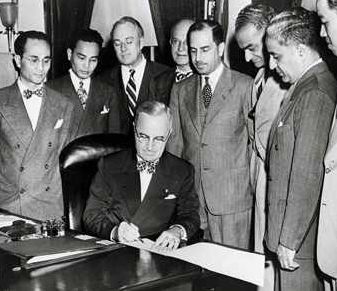
Luce–Celler Act of 1946
Encyclopedia

Emanuel Celler
Emanuel Celler was an American politician from New York who served in the United States House of Representatives for almost 50 years, from March 1923 to January 1973. He was a member of the Democratic Party.-Early life:...
in 1943 and signed into law by President Harry Truman on July 2, 1946. It re-established immigration from the Indian subcontinent
Indian subcontinent
The Indian subcontinent, also Indian Subcontinent, Indo-Pak Subcontinent or South Asian Subcontinent is a region of the Asian continent on the Indian tectonic plate from the Hindu Kush or Hindu Koh, Himalayas and including the Kuen Lun and Karakoram ranges, forming a land mass which extends...
and the Philippines
Philippines
The Philippines , officially known as the Republic of the Philippines , is a country in Southeast Asia in the western Pacific Ocean. To its north across the Luzon Strait lies Taiwan. West across the South China Sea sits Vietnam...
and granted naturalization rights to individuals from those regions. The imminent independence of India from Britain and the Philippines from the United States was an important factor in raising for review legislation regarding these nations and people from these nations.
This Act effectively ended statutory discrimination against these two Asian American groups once deemed 'unassimilable' along with most other Asian Americans. However, in 1946, people from the Indian subcontinent were referred to as "East Indian
Indian subcontinent
The Indian subcontinent, also Indian Subcontinent, Indo-Pak Subcontinent or South Asian Subcontinent is a region of the Asian continent on the Indian tectonic plate from the Hindu Kush or Hindu Koh, Himalayas and including the Kuen Lun and Karakoram ranges, forming a land mass which extends...
s"; they were not regarded as "Asian" at all but as part of the Caucasian race
Caucasian race
The term Caucasian race has been used to denote the general physical type of some or all of the populations of Europe, North Africa, the Horn of Africa, Western Asia , Central Asia and South Asia...
, consistent with the earlier Supreme Court
Supreme Court of the United States
The Supreme Court of the United States is the highest court in the United States. It has ultimate appellate jurisdiction over all state and federal courts, and original jurisdiction over a small range of cases...
opinion in 1923 (United States v. Bhagat Singh Thind
United States v. Bhagat Singh Thind
United States v. Bhagat Singh Thind, 261 U.S. 204 , was a case in which the United States Supreme Court decided that Bhagat Singh Thind, who was a Punjabi Sikh, settled in Oregon, could not be a naturalized citizen of the United States, because he was not a "white person" in the sense intended in...
) which had stated that they were Caucasian, but not white people
White people
White people is a term which usually refers to human beings characterized, at least in part, by the light pigmentation of their skin...
. (Between 1923 and 1965 with some minor exceptions in which many "non-white" nations were assigned token yearly immigration quotas of about 100 people each, only "white people" were allowed to immigrate to the United States in large numbers.) The term "South Asian" did not come into use until the 1970s. Filipinos were regarded in 1946 as part of the Malayan race, a subrace of the Mongolian race or East Asian race. Immigration rights were established as a mere token, allowing a mere 100 immigrants per year from India and 100 more from the Philippines.
External links
Note: half the sources cite Luce-Celler and July 2 while the other half cite Luce-Cellar and July 3; however, based on images of original documents, the correct spelling and date are Luce-Celler and July 2nd- http://www.pbs.org/rootsinthesand/a_lucecellar.html
- http://www.ailf.org/ipc/policy_reports_2004_eatingbitterness.asp

